Death Row: This Is What Really Happens To Your Body In The Electric Chair
By Kirsty
2 years ago
 Image Source / AP NewsThe usual routine is carried out for a prisoner on death row for their execution. They will be granted a final meal of their choice, offered the opportunity to speak with the prison pastor and eventually escorted from the cell when the time for execution arrives. The electric chair is not the sole method of execution these days, but it is one known option.
Image Source / AP NewsThe usual routine is carried out for a prisoner on death row for their execution. They will be granted a final meal of their choice, offered the opportunity to speak with the prison pastor and eventually escorted from the cell when the time for execution arrives. The electric chair is not the sole method of execution these days, but it is one known option. Image Source / New York MagazineEvery execution is required to have witnesses, even if family members are present as witnesses. Executions are always viewed through a viewing window and broadcast through screens and speakers (as usually happens with the lethal injection). Witnesses will be escorted through the prison to the viewing room.
Image Source / New York MagazineEvery execution is required to have witnesses, even if family members are present as witnesses. Executions are always viewed through a viewing window and broadcast through screens and speakers (as usually happens with the lethal injection). Witnesses will be escorted through the prison to the viewing room. Image Source / Encyclopaedia BritannicaIn order for death by electric chair to be more successful, the prisoner needs to be shaved. This only needs to be done on the places the electrodes (the electrical conductors) will touch the body - namely, the legs and the head. The reason for shaving is to reduce resistance to electricity that hairs might cause.
Image Source / Encyclopaedia BritannicaIn order for death by electric chair to be more successful, the prisoner needs to be shaved. This only needs to be done on the places the electrodes (the electrical conductors) will touch the body - namely, the legs and the head. The reason for shaving is to reduce resistance to electricity that hairs might cause. Image Source / BBCThe prisoner will need to be strapped firmly in place to the chair. For electrocution, the chair is in an upright position, and not a led-down gurney like with the lethal injection. The prisoner is bound in an upright sitting position, with thick belt straps put in place across the chest, groin, legs and arms.
Image Source / BBCThe prisoner will need to be strapped firmly in place to the chair. For electrocution, the chair is in an upright position, and not a led-down gurney like with the lethal injection. The prisoner is bound in an upright sitting position, with thick belt straps put in place across the chest, groin, legs and arms. Image Source / Encyclopaedia BritannicaThe reason that the prisoner needs to be strapped down so tightly into the chair is because of the potential for limbs to flail violently. This is why so many straps are needed in various places. The movement of limbs can be so severe it can even cause dislocation.
Image Source / Encyclopaedia BritannicaThe reason that the prisoner needs to be strapped down so tightly into the chair is because of the potential for limbs to flail violently. This is why so many straps are needed in various places. The movement of limbs can be so severe it can even cause dislocation. Image Source / BiolindoA wet sponge is used to better conduct electricity and make for a quicker, less painful death. The sponge needs to have the right amount of moisture to efficiently conduct the current - if it's too wet, it could risk short-circuiting the current. And if you're a fan of the movie The Green Mile, then you'll know what happens when a dry sponge is used...
Image Source / BiolindoA wet sponge is used to better conduct electricity and make for a quicker, less painful death. The sponge needs to have the right amount of moisture to efficiently conduct the current - if it's too wet, it could risk short-circuiting the current. And if you're a fan of the movie The Green Mile, then you'll know what happens when a dry sponge is used... Image Source / History TodayThe target of electrocution is directly into the head to hit the brain. This is why a type of skullcap is fitted and pulled over the prisoner's head with the electrodes attached. The scalp should cover all of the head as well as the forehead. The skullcap should be pulled over the sponge so the sponge is between the cap and head.
Image Source / History TodayThe target of electrocution is directly into the head to hit the brain. This is why a type of skullcap is fitted and pulled over the prisoner's head with the electrodes attached. The scalp should cover all of the head as well as the forehead. The skullcap should be pulled over the sponge so the sponge is between the cap and head. Image Source / Simple WikipediaIn order to give a better chance to have electrodes working in all the right places, an additional electrode is moistened with jelly made to better conduct electricity and then attached to the shaved portion of the prisoner's leg.
Image Source / Simple WikipediaIn order to give a better chance to have electrodes working in all the right places, an additional electrode is moistened with jelly made to better conduct electricity and then attached to the shaved portion of the prisoner's leg. Image Source / UnsplashThis is done for two reasons. It makes it easier and less personal on the executioners turning on the electric chair, that they don't have to meet the eyes of the person they're killing. For the prisoner, it means they have a moment of security in not having to look at their killers, and not having to watch as the chair is switched on.
Image Source / UnsplashThis is done for two reasons. It makes it easier and less personal on the executioners turning on the electric chair, that they don't have to meet the eyes of the person they're killing. For the prisoner, it means they have a moment of security in not having to look at their killers, and not having to watch as the chair is switched on. Image Source / NPRThe team of people responsible for fitting the prisoner into the chair now need to withdraw. Only the executioner themselves should remain. The team withdraw to the viewing room to observe the execution carried out. This is also viewed by the witnessed who were gathered.
Image Source / NPRThe team of people responsible for fitting the prisoner into the chair now need to withdraw. Only the executioner themselves should remain. The team withdraw to the viewing room to observe the execution carried out. This is also viewed by the witnessed who were gathered. Image Source / WikipediaWhen the moment has arrived, the warden will be the one to give the signal. They will let the executioner know when it's time. The executioner needs to wait for the official signal before they can pull the lever to begin the electric current.
Image Source / WikipediaWhen the moment has arrived, the warden will be the one to give the signal. They will let the executioner know when it's time. The executioner needs to wait for the official signal before they can pull the lever to begin the electric current. Image Source / NBC12When the signal is given, the handle is pulled to connect the power supply. The electric current will be a jolt of between 500 to 2000 volts. The duration of the voltage will be about 30 seconds, during which time the prisoner will be seen being electrocuted and - if successful - killed.
Image Source / NBC12When the signal is given, the handle is pulled to connect the power supply. The electric current will be a jolt of between 500 to 2000 volts. The duration of the voltage will be about 30 seconds, during which time the prisoner will be seen being electrocuted and - if successful - killed. Image Source / Electric Chair DeathsThe electric current heats the body and internal organs so severely that it is literally cooking the body. In worst cases, the body can even catch fire completely in response to the current. Witnesses to an execution by electric chair have even reported a sound like bacon being fried.
Image Source / Electric Chair DeathsThe electric current heats the body and internal organs so severely that it is literally cooking the body. In worst cases, the body can even catch fire completely in response to the current. Witnesses to an execution by electric chair have even reported a sound like bacon being fried. Image Source / WBIR.comYou can only imagine the horrible sicky smell of burnt flesh that must fill the small execution chamber. If the sounds are like frying bacon, then it must smell like the body being cooked, too. Especially if the prisoner catches fire, the smell of burning must be overpowering.
Image Source / WBIR.comYou can only imagine the horrible sicky smell of burnt flesh that must fill the small execution chamber. If the sounds are like frying bacon, then it must smell like the body being cooked, too. Especially if the prisoner catches fire, the smell of burning must be overpowering. Image Source / FacebookAnother reason the blindfold may be needed. Not only can the prisoner's eyeballs pop out from their head due to the surge of electricity, but they could completely come out of their socket and even rest on their cheeks.
Image Source / FacebookAnother reason the blindfold may be needed. Not only can the prisoner's eyeballs pop out from their head due to the surge of electricity, but they could completely come out of their socket and even rest on their cheeks. Image Source / WikipediaOr maybe all of the above. Because of the insanely high temperatures that are forced into the body and heating everything up from the inside, the eyeballs could even melt as well as pop from the head. You'd think a blindfold would make no difference if this is the case!
Image Source / WikipediaOr maybe all of the above. Because of the insanely high temperatures that are forced into the body and heating everything up from the inside, the eyeballs could even melt as well as pop from the head. You'd think a blindfold would make no difference if this is the case! Image Source / Science Museum Group CollectionThis could be completely involuntarily if the current surge causes such violent movement of limbs, but in a lot of cases, the hands can be seen gripping the arms of the chair while strapped in as the current flows through.
Image Source / Science Museum Group CollectionThis could be completely involuntarily if the current surge causes such violent movement of limbs, but in a lot of cases, the hands can be seen gripping the arms of the chair while strapped in as the current flows through. Image Source / Getwell Urgent CareWith such high temperatures, and especially ones so high to potentially melt the eyeballs, it's no surprise that pieces of skin may actually burn off, too. The amount of heat rushing through the body will cause severe burns on the skin - and, in worst cases, strip the flesh away.
Image Source / Getwell Urgent CareWith such high temperatures, and especially ones so high to potentially melt the eyeballs, it's no surprise that pieces of skin may actually burn off, too. The amount of heat rushing through the body will cause severe burns on the skin - and, in worst cases, strip the flesh away. Image Source / Vascular SocietyDue to the massive amount of heat, the body could also visibly swell up, too. The flesh can swell, burn and stretch to breaking point (as mentioned in the previous vivid point) so that the body is really being pushed to its limit.
Image Source / Vascular SocietyDue to the massive amount of heat, the body could also visibly swell up, too. The flesh can swell, burn and stretch to breaking point (as mentioned in the previous vivid point) so that the body is really being pushed to its limit. Image Source / Carr SubaruIt's no surprise that you'll see physical evidence of the burning, too, as well as smelling the scent of burnt flesh. You may actually see smoke and steam rising from the body as it's being pushed to extreme temperatures and 'cooked'.
Image Source / Carr SubaruIt's no surprise that you'll see physical evidence of the burning, too, as well as smelling the scent of burnt flesh. You may actually see smoke and steam rising from the body as it's being pushed to extreme temperatures and 'cooked'. Image Source / Medical News TodayIt's also no surprise the skin is going to visibly change colour - and, namely, bright red. The body is being heated to extreme conditions and as a response to the burns and high heat, the skin (even if not burned completely away) will turn bright red as well as swelling up.
Image Source / Medical News TodayIt's also no surprise the skin is going to visibly change colour - and, namely, bright red. The body is being heated to extreme conditions and as a response to the burns and high heat, the skin (even if not burned completely away) will turn bright red as well as swelling up. Image Source / WikipediaYou hear enough stories about the body emptying its bowls when faced with death or moments of fear. For the electric chair, everything imaginable will often occur. This means defecation and urination, even vomiting, and visible blood and drool may be released, too.
Image Source / WikipediaYou hear enough stories about the body emptying its bowls when faced with death or moments of fear. For the electric chair, everything imaginable will often occur. This means defecation and urination, even vomiting, and visible blood and drool may be released, too. Image Source / Space.comWe've all had that weird sensation when we get an electric shock, like when you get a reaction on the car door. That weird feeling is actually the sensation of your own electrons moving about. For the electric chair, the current that moves through is the body's electrons running into each other in a chain.
Image Source / Space.comWe've all had that weird sensation when we get an electric shock, like when you get a reaction on the car door. That weird feeling is actually the sensation of your own electrons moving about. For the electric chair, the current that moves through is the body's electrons running into each other in a chain. Image Source / Style WeeklyAfter the current is surged through the body, the lever is turned off. The body should then fall still. This is the time for the doctors to check whether the prisoner is still alive - but they will need to wait a moment for the body to cool down. They then check if the prisoner's heart is still beating.
Image Source / Style WeeklyAfter the current is surged through the body, the lever is turned off. The body should then fall still. This is the time for the doctors to check whether the prisoner is still alive - but they will need to wait a moment for the body to cool down. They then check if the prisoner's heart is still beating. Image Source / NBC NewsElectrocutions may not actually be successful on the first try, which means the prisoner will need to be subjected to another round of electricity. It may not even work the second time, either. Basically surges need to be continually given until the prisoner is dead - no matter how long it takes.
Image Source / NBC NewsElectrocutions may not actually be successful on the first try, which means the prisoner will need to be subjected to another round of electricity. It may not even work the second time, either. Basically surges need to be continually given until the prisoner is dead - no matter how long it takes. Image Source / QuoraWhen the electrocution has successfully been carried out and the prisoner is declared dead, the viewing window will be closed and witnesses will be escorted to leave. The body will then need to be removed for an autopsy and to prepare for the remains to be interred.
Image Source / QuoraWhen the electrocution has successfully been carried out and the prisoner is declared dead, the viewing window will be closed and witnesses will be escorted to leave. The body will then need to be removed for an autopsy and to prepare for the remains to be interred. Image Source / NPRAn autopsy of the body cannot be immediately carried out due to how hot to the touch it will be - and this isn't just about skin temperature, either. An electrocution heats up the internal organs, so coroners must wait until they cool. The body is so hot after electrocution that it can cause blisters.
Image Source / NPRAn autopsy of the body cannot be immediately carried out due to how hot to the touch it will be - and this isn't just about skin temperature, either. An electrocution heats up the internal organs, so coroners must wait until they cool. The body is so hot after electrocution that it can cause blisters. Image Source / NCBIThe burnt condition of the skin will be even more severe at the sites where the electrodes were attached to the skin. This will be on the scalp and the legs. The skin will most likely be black due to third degree burns.
Image Source / NCBIThe burnt condition of the skin will be even more severe at the sites where the electrodes were attached to the skin. This will be on the scalp and the legs. The skin will most likely be black due to third degree burns. Image Source / Scientific AmericanThe deputy chief medical examiner of Cook County reported that, with autopsy following the electric chair, the brain looks to be 'cooked' in most cases. It's no surprise when the head and scalp is the focus of the skullcap, with the electric surge straight into the head.
Image Source / Scientific AmericanThe deputy chief medical examiner of Cook County reported that, with autopsy following the electric chair, the brain looks to be 'cooked' in most cases. It's no surprise when the head and scalp is the focus of the skullcap, with the electric surge straight into the head. Image Source / WPTVIt's clear that the electricity kills the person, but it's more debateable about how. It's likely that the cause of death is the brain being paralysed by the electric current, or the body being thrown into cardiac arrest due to the extreme voltage. If a prisoner sets on fire during a failed electric chair attempt, it could even be that that ultimately kills them.
Image Source / WPTVIt's clear that the electricity kills the person, but it's more debateable about how. It's likely that the cause of death is the brain being paralysed by the electric current, or the body being thrown into cardiac arrest due to the extreme voltage. If a prisoner sets on fire during a failed electric chair attempt, it could even be that that ultimately kills them. Image Source / FOX 10 PhoenixAny prisoner preparing for their execution is granted a last meal. This can be anything they demand, no matter how outrageous it may seem. A lot of the time, final meals are more on the junk food side, such as pizzas and burgers, or may be decadent requests like steaks. The prisoner is also then given the option to have a final conversation with the prison chaplain.
Image Source / FOX 10 PhoenixAny prisoner preparing for their execution is granted a last meal. This can be anything they demand, no matter how outrageous it may seem. A lot of the time, final meals are more on the junk food side, such as pizzas and burgers, or may be decadent requests like steaks. The prisoner is also then given the option to have a final conversation with the prison chaplain. Image Source / The New York TimesPrisoners facing execution will need to be officially placed on death row, the cells inhabited only by those who are facing the end of their life and prison term. This move will need to be done in preparation for the upcoming execution, and these death row cells are under 24 hour surveillance. They're also extremely close to the execution chamber itself.
Image Source / The New York TimesPrisoners facing execution will need to be officially placed on death row, the cells inhabited only by those who are facing the end of their life and prison term. This move will need to be done in preparation for the upcoming execution, and these death row cells are under 24 hour surveillance. They're also extremely close to the execution chamber itself. Image Source / NBC NewsExecutions are broadcast on closed circuit televisions and through audio systems. This is so those who need to witness the execution can do so via television and audio. On the day of the execution, these systems need to be checked to make sure the execution will be broadcast successfully.
Image Source / NBC NewsExecutions are broadcast on closed circuit televisions and through audio systems. This is so those who need to witness the execution can do so via television and audio. On the day of the execution, these systems need to be checked to make sure the execution will be broadcast successfully. Image Source / Outsourcing-PharmaOn the same day, prison staff will go to (what is described as) secure storage, where the chemicals for the lethal injection are stored. These needed to be checked and prepared on execution day to make sure everything is in order.
Image Source / Outsourcing-PharmaOn the same day, prison staff will go to (what is described as) secure storage, where the chemicals for the lethal injection are stored. These needed to be checked and prepared on execution day to make sure everything is in order. Image Source / BBCThree drugs are used for lethal injections, all of which injected into the prisoner's body. The drugs are midazolam, vecuronium bromide and potassium chloride. There should be enough of the drugs to make two sets of nine syringes each. These will then be color-coded: red for the ones to be used, and blue for the backup set in case the first set is compromised. Witnesses are also present to watch the syringes being filled.
Image Source / BBCThree drugs are used for lethal injections, all of which injected into the prisoner's body. The drugs are midazolam, vecuronium bromide and potassium chloride. There should be enough of the drugs to make two sets of nine syringes each. These will then be color-coded: red for the ones to be used, and blue for the backup set in case the first set is compromised. Witnesses are also present to watch the syringes being filled. Image Source / Mississippi TodayA prison system will have a waiting area for execution teams to be used on execution day. The execution team, appointed by the state, will be taken to the waiting room, and their identities are only known by those for whom it's absolutely necessary.
Image Source / Mississippi TodayA prison system will have a waiting area for execution teams to be used on execution day. The execution team, appointed by the state, will be taken to the waiting room, and their identities are only known by those for whom it's absolutely necessary. Image Source / Manchester Evening NewsThe prisoner will need to be changed and dressed for their execution clothing. Often this will be another set of normal prison clothes and will usually be cotton, such as a plain cotton shirt, cotton trousers and then socks and cloth shoes.
Image Source / Manchester Evening NewsThe prisoner will need to be changed and dressed for their execution clothing. Often this will be another set of normal prison clothes and will usually be cotton, such as a plain cotton shirt, cotton trousers and then socks and cloth shoes. Image Source / The New York TimesThe official execution witnesses will then report to the state prison and be escorted through the official prison checkout. They will then be taken to their waiting area, where they will remain until it's time for the official execution. When this time arrives, they will be escorted to the witness area.
Image Source / The New York TimesThe official execution witnesses will then report to the state prison and be escorted through the official prison checkout. They will then be taken to their waiting area, where they will remain until it's time for the official execution. When this time arrives, they will be escorted to the witness area. Image Source / WikipediaThe lethal injection recorder is a member of prison staff who is tasked with monitoring the injection process, as well as ensuring the execution team remains anonymous. The recorder will go with an emergency medical technician into the execution chamber to prepare. This preparation also includes checking the phones in the chamber are working.
Image Source / WikipediaThe lethal injection recorder is a member of prison staff who is tasked with monitoring the injection process, as well as ensuring the execution team remains anonymous. The recorder will go with an emergency medical technician into the execution chamber to prepare. This preparation also includes checking the phones in the chamber are working. Image Source / Medical Examiner-CoronerThe prison will have a capital punishment garage, which is where the medical examiner will have their medical vehicle stored in wait. This is where the body of the prisoner will be taken after the execution, and a member of the medical examiner's staff, as well as a doctor, will go to the garage while preparations are being made.
Image Source / Medical Examiner-CoronerThe prison will have a capital punishment garage, which is where the medical examiner will have their medical vehicle stored in wait. This is where the body of the prisoner will be taken after the execution, and a member of the medical examiner's staff, as well as a doctor, will go to the garage while preparations are being made. Image Source / Victorville Daily PressIf the prisoner has living family members, they may be present for the execution. If any family members of the victim are there, they will be escorted with the official witnesses to the waiting area in the prison to make sure they're now ready for the imminent execution.
Image Source / Victorville Daily PressIf the prisoner has living family members, they may be present for the execution. If any family members of the victim are there, they will be escorted with the official witnesses to the waiting area in the prison to make sure they're now ready for the imminent execution. Image Source / Tampa Bay TimesAn extraction team will then go to the prisoner's cell in order to collect them. When doing so, they will request the prisoner approach the cell door with their hands through the bars so they can be handcuffed. Once done, the prisoner will be instructed to move to the back of the cell and place their hands on the wall. If the prisoner refuses to come willingly for the execution, they will be removed forcibly from the cell.
Image Source / Tampa Bay TimesAn extraction team will then go to the prisoner's cell in order to collect them. When doing so, they will request the prisoner approach the cell door with their hands through the bars so they can be handcuffed. Once done, the prisoner will be instructed to move to the back of the cell and place their hands on the wall. If the prisoner refuses to come willingly for the execution, they will be removed forcibly from the cell. Image Source / TRT WorldOnce removed from the cell, whether peacefully or forcibly, the prisoner is then placed on a gurney and restrained to it in a led-down position. This gurney will then be escorted and pushed into the execution chamber for the IV lines to be fitted.
Image Source / TRT WorldOnce removed from the cell, whether peacefully or forcibly, the prisoner is then placed on a gurney and restrained to it in a led-down position. This gurney will then be escorted and pushed into the execution chamber for the IV lines to be fitted. Image Source / LADbibleDuring the IV placement, the state's attorney as well as the prisoner's attorney should both be present in the execution chamber, until the IVs are fully secured. These fluid lines are placed in the prisoner's arms to prepare for the lethal chemicals. During this time, any family members as well as the witnesses will be taken to the official witness rooms.
Image Source / LADbibleDuring the IV placement, the state's attorney as well as the prisoner's attorney should both be present in the execution chamber, until the IVs are fully secured. These fluid lines are placed in the prisoner's arms to prepare for the lethal chemicals. During this time, any family members as well as the witnesses will be taken to the official witness rooms. Image Source / Otago Daily TimesOnce the IVs are secured in place, the same team will tape and secure the prisoner's arms to the arm supports of the gurney. The arms will need to be secured so that the hands are palm up, in the usual way for an injection. The two attorneys are then moved out of the execution chamber and to a witness room.
Image Source / Otago Daily TimesOnce the IVs are secured in place, the same team will tape and secure the prisoner's arms to the arm supports of the gurney. The arms will need to be secured so that the hands are palm up, in the usual way for an injection. The two attorneys are then moved out of the execution chamber and to a witness room. Image Source / SoapboxieOnce all the witnesses have been placed in the correct viewing areas, including the two attorneys from the execution chamber, the closed circuit television and audio systems which were checked earlier will now be activated to begin the feed.
Image Source / SoapboxieOnce all the witnesses have been placed in the correct viewing areas, including the two attorneys from the execution chamber, the closed circuit television and audio systems which were checked earlier will now be activated to begin the feed. Image Source / New York MagazineIn the witness rooms, blinds will have been pulled over the viewing window up to this point, to shield the preparation events taking place in the execution chamber. At this point when the execution is ready to begin, the blinds will be opened, revealing the execution chamber.
Image Source / New York MagazineIn the witness rooms, blinds will have been pulled over the viewing window up to this point, to shield the preparation events taking place in the execution chamber. At this point when the execution is ready to begin, the blinds will be opened, revealing the execution chamber. Image Source / BBCThere was a reason that the phones needed to be checked earlier during the preparation phase. This is because there is always a chance a last-minute phone call will be made to stay the execution. The Department of Correction commissioner will therefore need to be contacted at this point to check whether there is any last-minute stay of execution.
Image Source / BBCThere was a reason that the phones needed to be checked earlier during the preparation phase. This is because there is always a chance a last-minute phone call will be made to stay the execution. The Department of Correction commissioner will therefore need to be contacted at this point to check whether there is any last-minute stay of execution. Image Source / All That's InterestingIf there is no official reason to stop the execution, it will then proceed. After the check is made, the prisoner will then be given the opportunity to speak their final words. Some prisoners may choose to say nothing, others may make big speeches. They might express guilt over what they did, or they may maintain they did the right thing.
Image Source / All That's InterestingIf there is no official reason to stop the execution, it will then proceed. After the check is made, the prisoner will then be given the opportunity to speak their final words. Some prisoners may choose to say nothing, others may make big speeches. They might express guilt over what they did, or they may maintain they did the right thing. Image Source / New York MagazineAfter the prisoner's statement is officially complete, the execution begins. The lethal injection recorder (the attendant responsible for monitoring the process) will note down the execution's start time after the signal is given to begin administering the first dose.
Image Source / New York MagazineAfter the prisoner's statement is officially complete, the execution begins. The lethal injection recorder (the attendant responsible for monitoring the process) will note down the execution's start time after the signal is given to begin administering the first dose. Image Source / The Marshall ProjectThe first syringe is the midazolam. After the start signal is given, the executioner places the first syringe into the line. The plunger will be pushed at a steady pace. Two syringes in total of midazolam will be used, fed into the line and into the prisoner's arm. The purpose of the midazolam, and the reason it's inserted first, is to put the prisoner to sleep.
Image Source / The Marshall ProjectThe first syringe is the midazolam. After the start signal is given, the executioner places the first syringe into the line. The plunger will be pushed at a steady pace. Two syringes in total of midazolam will be used, fed into the line and into the prisoner's arm. The purpose of the midazolam, and the reason it's inserted first, is to put the prisoner to sleep. Image Source / News-Medical.netThe IV line then needs to be flushed and cleared of midazolam before the next drug can be administered. This is therefore done with a saline flush after the two injections of midazolam have been given. This is also a key point for checks to be made. If the executioner feels resistance on the plunger, they pull back. The line is supposed to fill with blood, so if it doesn't, the executioner will no longer use that line. This may then mean the process needs to be restarted with the other line in the other arm, and using the backup blue-coded syringes.
Image Source / News-Medical.netThe IV line then needs to be flushed and cleared of midazolam before the next drug can be administered. This is therefore done with a saline flush after the two injections of midazolam have been given. This is also a key point for checks to be made. If the executioner feels resistance on the plunger, they pull back. The line is supposed to fill with blood, so if it doesn't, the executioner will no longer use that line. This may then mean the process needs to be restarted with the other line in the other arm, and using the backup blue-coded syringes. Image Source / Voice of AmericaBecause the purpose of the midazolam is to put the prisoner to sleep, the prisoner needs to be checked to see if they are still conscious and if the midazolam has worked. The purpose of giving the midazolam and putting to sleep is to make it so that the prisoner doesn't feel any pain caused by the lethal injection of the remaining chemicals.
Image Source / Voice of AmericaBecause the purpose of the midazolam is to put the prisoner to sleep, the prisoner needs to be checked to see if they are still conscious and if the midazolam has worked. The purpose of giving the midazolam and putting to sleep is to make it so that the prisoner doesn't feel any pain caused by the lethal injection of the remaining chemicals. Image Source / NC Coalition for Alternatives to the Death PenaltyChecks are necessary because prisoners can actually appear unconscious even though they can still fully feel everything going on. Checks might include brushing a hand over the eyelashes of the prisoner, physically grabbing and pulling on their shoulder, and calling their name. A witness will also watch this 'checking' process and document it.
Image Source / NC Coalition for Alternatives to the Death PenaltyChecks are necessary because prisoners can actually appear unconscious even though they can still fully feel everything going on. Checks might include brushing a hand over the eyelashes of the prisoner, physically grabbing and pulling on their shoulder, and calling their name. A witness will also watch this 'checking' process and document it. Image Source / Death Penalty Information CenterIf the prisoner is still responsive, the backup set of midazolam will be ordered to be used through the second IV line to try again. When the prisoner is confirmed to be unconscious, the executioner will be ordered to administer the second, and then third drugs. The second drug is vecuronium bromide, designed to paralyze the muscles. This is followed by another saline flush before the third drug is given: two syringes of potassium chloride. This final dose is designed to stop the prisoner's heart.
Image Source / Death Penalty Information CenterIf the prisoner is still responsive, the backup set of midazolam will be ordered to be used through the second IV line to try again. When the prisoner is confirmed to be unconscious, the executioner will be ordered to administer the second, and then third drugs. The second drug is vecuronium bromide, designed to paralyze the muscles. This is followed by another saline flush before the third drug is given: two syringes of potassium chloride. This final dose is designed to stop the prisoner's heart. Image Source / Las Vegas Review-JournalFollowing the successful insertion of all three drugs, the viewing blinds remain open for five minutes. During this time, the prisoner shouldn't be reacting to the pain of death, as the successful input of the midazolam means the prisoner shouldn't feel or react to anything. When the five minutes have passed, the blinds will close and the TV/audio feed turned off.
Image Source / Las Vegas Review-JournalFollowing the successful insertion of all three drugs, the viewing blinds remain open for five minutes. During this time, the prisoner shouldn't be reacting to the pain of death, as the successful input of the midazolam means the prisoner shouldn't feel or react to anything. When the five minutes have passed, the blinds will close and the TV/audio feed turned off. Image Source / New York MagazineAfter the blinds have closed, a physician will enter the execution chamber to confirm the death. They will examine the prisoner's body and pronounce the time of death, or they will confirm they are still alive if that is the case. If still alive, the execution would have to be attempted again.
Image Source / New York MagazineAfter the blinds have closed, a physician will enter the execution chamber to confirm the death. They will examine the prisoner's body and pronounce the time of death, or they will confirm they are still alive if that is the case. If still alive, the execution would have to be attempted again. Image Source / AZCentralWhen the death has officially been checked and confirmed, it will be announced to all the witnesses, stating the prisoner's name and confirmation that the penalty has been carried out. Witnesses will then be asked to exit, where they will be escorted out of the prison. The commissioner will then also be informed of the prisoner's death.
Image Source / AZCentralWhen the death has officially been checked and confirmed, it will be announced to all the witnesses, stating the prisoner's name and confirmation that the penalty has been carried out. Witnesses will then be asked to exit, where they will be escorted out of the prison. The commissioner will then also be informed of the prisoner's death. Image Source / British GQThe extraction team will then remove the restraints on the prisoner's body, freeing it from the gurney. The medical examiner team will then remove the body from the execution chamber and take it to the capital punishment garage, where the medical examiner's vehicle will be waiting for the body.
Image Source / British GQThe extraction team will then remove the restraints on the prisoner's body, freeing it from the gurney. The medical examiner team will then remove the body from the execution chamber and take it to the capital punishment garage, where the medical examiner's vehicle will be waiting for the body. Image Source / The Journal.ieBurial arrangements will then need to be made for the body. The prison chaplain should be informed about any necessary arrangements. Often, prisoners may not have family members, however. If there is no family member to claim the body for funeral, then a pauper's burial will be arranged by the prison warden (which means a basic state-funded cremation or burial).
Image Source / The Journal.ieBurial arrangements will then need to be made for the body. The prison chaplain should be informed about any necessary arrangements. Often, prisoners may not have family members, however. If there is no family member to claim the body for funeral, then a pauper's burial will be arranged by the prison warden (which means a basic state-funded cremation or burial).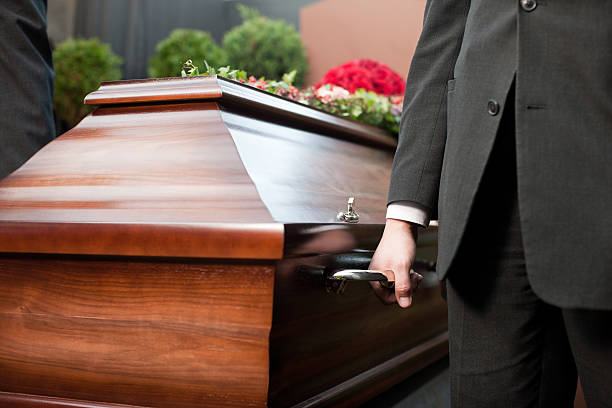 When someone dies, the body has to be transferred to the morticians. For example if the person was at hospital or a nursing home then body is driven to an morticians. But if the circumstances are not as clear then first the body has to be taken to the coroners before entering the morticians to discern how they died.
When someone dies, the body has to be transferred to the morticians. For example if the person was at hospital or a nursing home then body is driven to an morticians. But if the circumstances are not as clear then first the body has to be taken to the coroners before entering the morticians to discern how they died.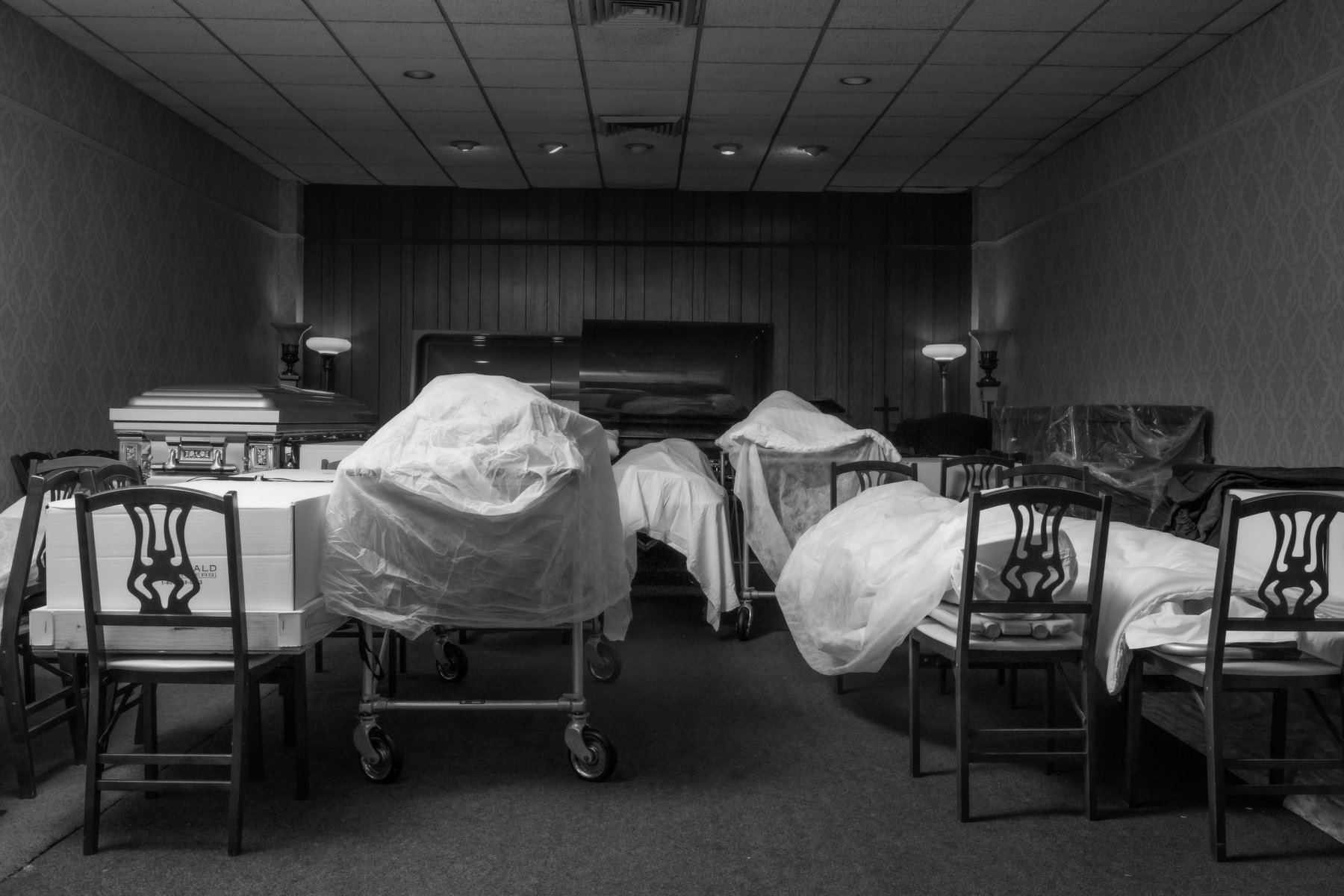 One of the first steps after retrieving the body is to check it for anything in particular. This could be anything from a pace maker to whether the body has a disease, or whether any fluids are coming from the body. This is because depending on the body, it will have to be treated in a different way.
One of the first steps after retrieving the body is to check it for anything in particular. This could be anything from a pace maker to whether the body has a disease, or whether any fluids are coming from the body. This is because depending on the body, it will have to be treated in a different way.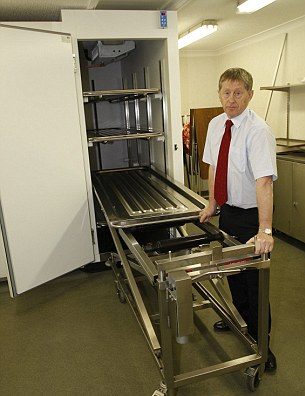 After assessing the body, it is then loaded onto a mortuary tray which can be metal or plastic, with wheels so that it can be easily transferred into the fridge. Then, the body is placed straight into the fridge as soon as possible so that it stops it from decomposing quickly.
After assessing the body, it is then loaded onto a mortuary tray which can be metal or plastic, with wheels so that it can be easily transferred into the fridge. Then, the body is placed straight into the fridge as soon as possible so that it stops it from decomposing quickly.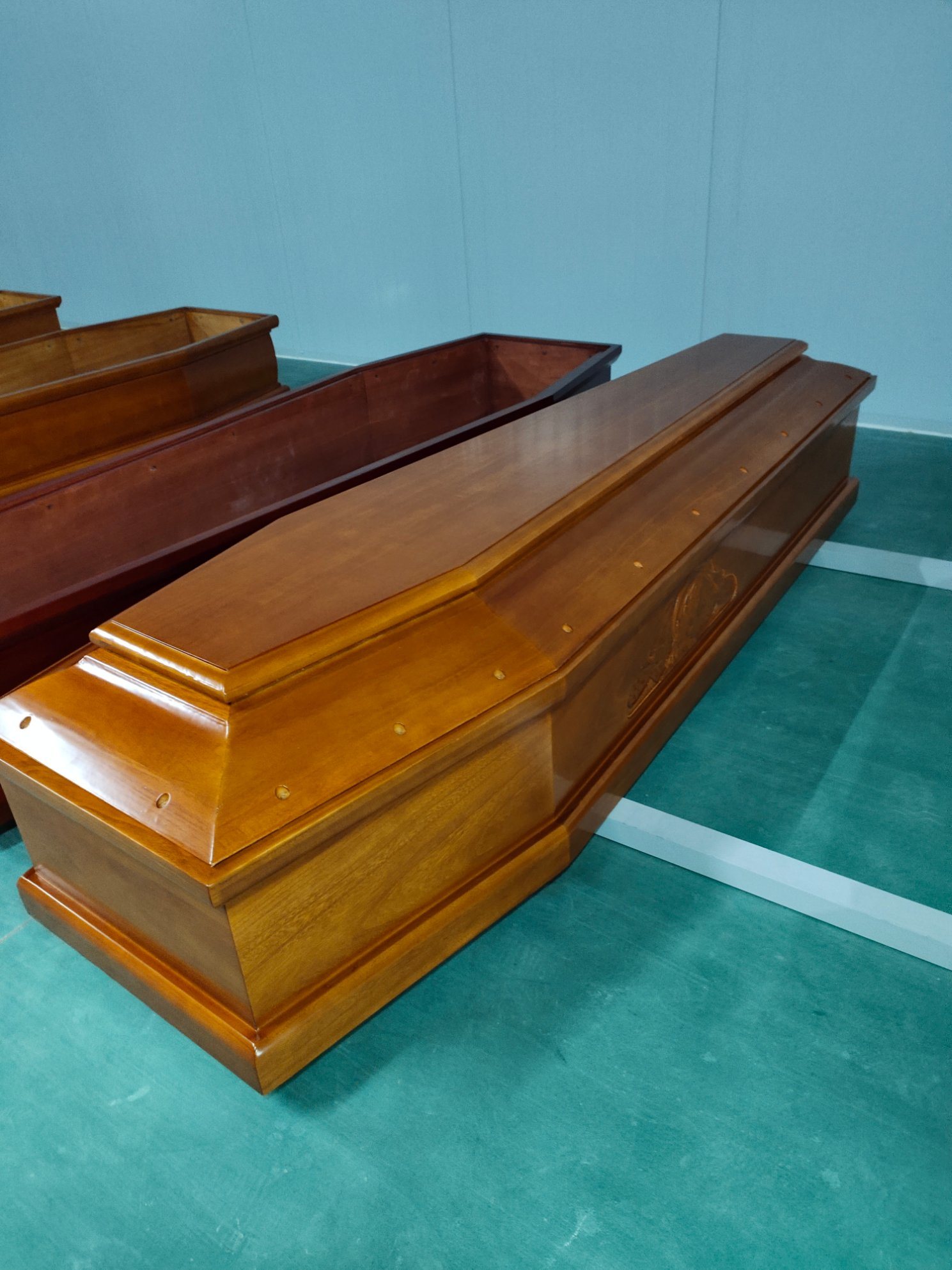 The head is placed higher than the rest of the body to avoid what is called in the mortician process as 'purging'. Purging refers to "leakage" from the mouth or the nose. The fluids that leak out can be for example, from blood or bile and so this is avoided where possible.
The head is placed higher than the rest of the body to avoid what is called in the mortician process as 'purging'. Purging refers to "leakage" from the mouth or the nose. The fluids that leak out can be for example, from blood or bile and so this is avoided where possible. The clothes on the body of course have to be removed, which of course can take some work depending on how the person was dressed when they sadly died. Their clothes are carefully stored away and then they re-dress the body with a gown resembling those from hospital.
The clothes on the body of course have to be removed, which of course can take some work depending on how the person was dressed when they sadly died. Their clothes are carefully stored away and then they re-dress the body with a gown resembling those from hospital.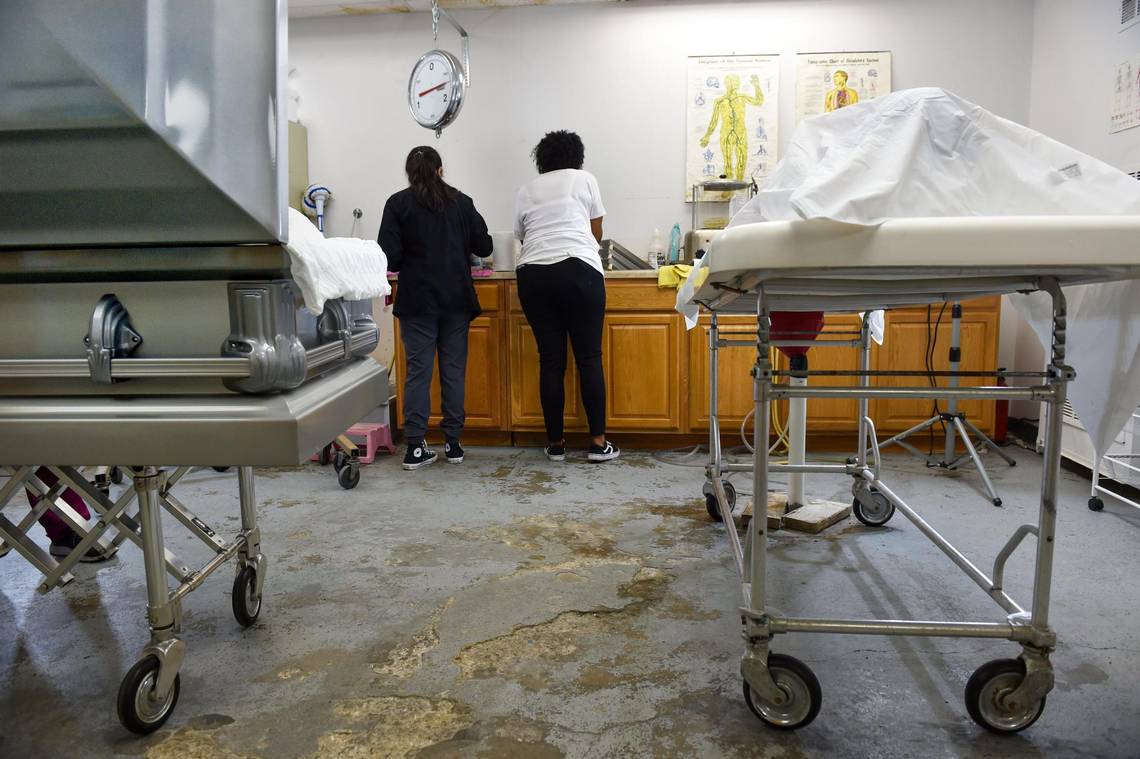 Of course another essential step is that the body is cleaned. This varies for each person depending on the state of the body. In most cases it does not require much of a cleaning process, but some bodies are more 'messy' and so the cleaning has to be more thorough.
Of course another essential step is that the body is cleaned. This varies for each person depending on the state of the body. In most cases it does not require much of a cleaning process, but some bodies are more 'messy' and so the cleaning has to be more thorough.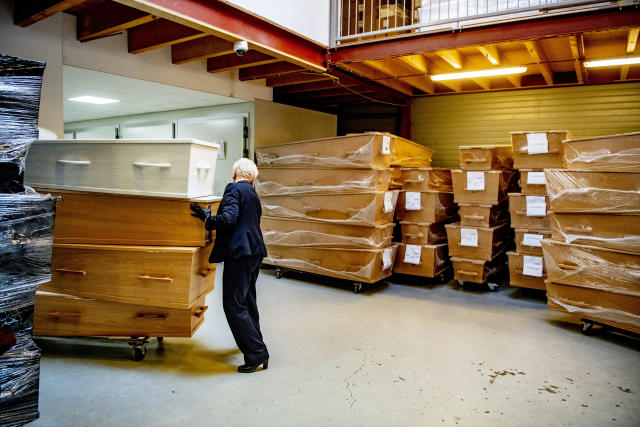 The first item of clothing to be put on is the underwear, to make sure the body is covered. Bodies are covered as soon as possible with underwear to protect the dignity and respect of the person who is deceased and also for the sake of the mortician too.
The first item of clothing to be put on is the underwear, to make sure the body is covered. Bodies are covered as soon as possible with underwear to protect the dignity and respect of the person who is deceased and also for the sake of the mortician too.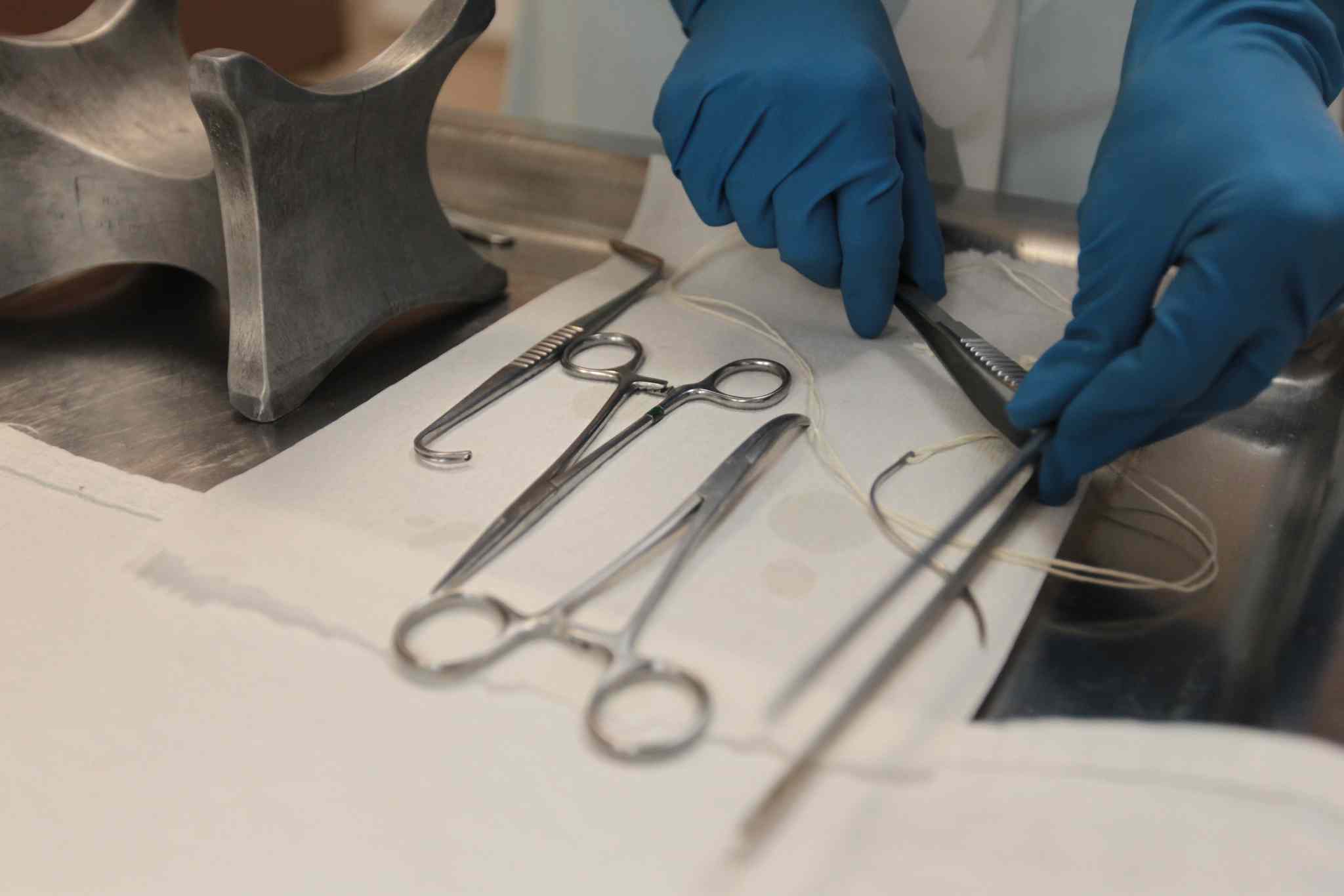 When someone dies, the eyes naturally sink in leaving noticeable dents in the face. And so "eye caps" are place inside the eye to prevent this. These are just small little flesh coloured disks which are inserted underneath the eye lids. They have tiny spikes on the outer side in order to hold the eyes closed.
When someone dies, the eyes naturally sink in leaving noticeable dents in the face. And so "eye caps" are place inside the eye to prevent this. These are just small little flesh coloured disks which are inserted underneath the eye lids. They have tiny spikes on the outer side in order to hold the eyes closed.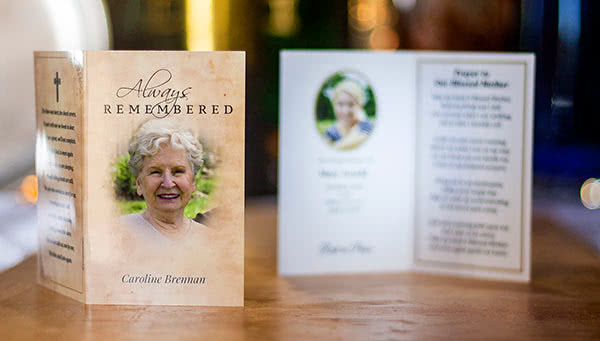 This also depends on the situation. But, a little bit of makeup is often applied so that the person looks more like themselves and to add some colour back into the face. This is done mainly for the sake of the grieving family who may want to visit the body.
This also depends on the situation. But, a little bit of makeup is often applied so that the person looks more like themselves and to add some colour back into the face. This is done mainly for the sake of the grieving family who may want to visit the body.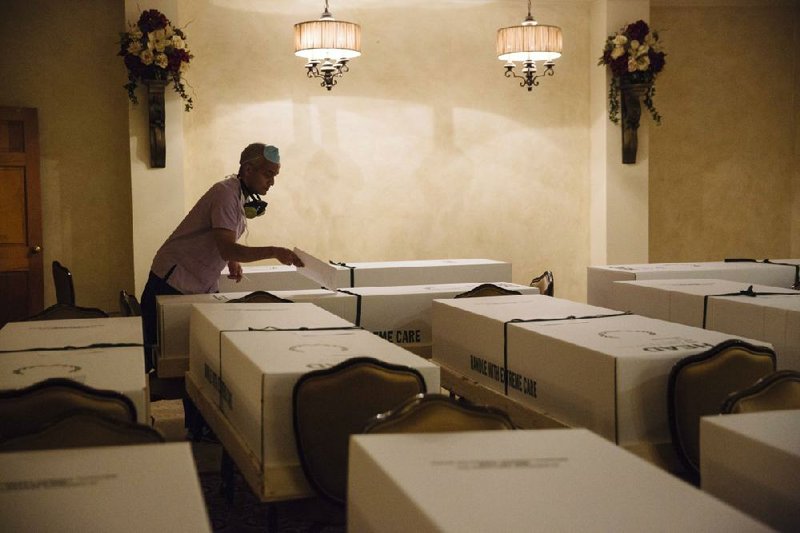 Because fluids naturally secrete from the nose and mouth, they are essentially plugged. This is done by taking cotton wadding and placing it down the throat as well as up the nose in order to prevent leakage so that the body can be preserved properly.
Because fluids naturally secrete from the nose and mouth, they are essentially plugged. This is done by taking cotton wadding and placing it down the throat as well as up the nose in order to prevent leakage so that the body can be preserved properly.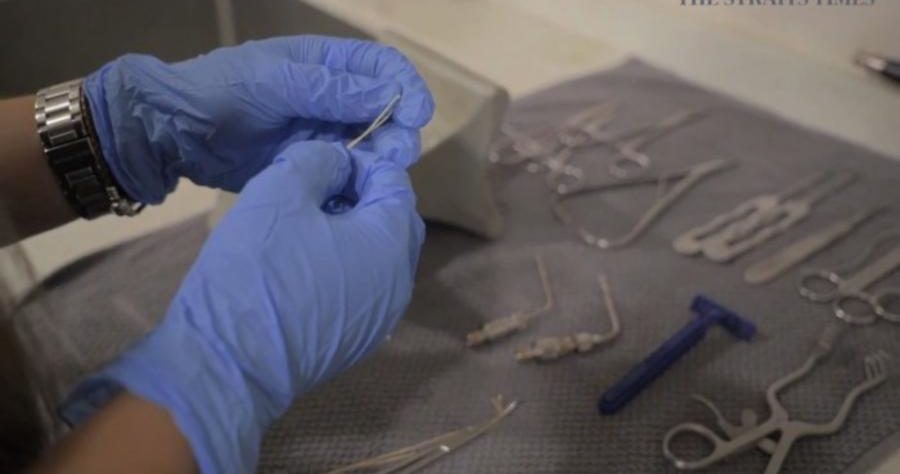 This point sounds a little bit strange and it is an idea that can sound shocking to those who are not inside the secrets of he mortician process. But it is delicately done by taking a needle and inserting i inside the throat first. Then the mouth is effectively sealed shut so that it cannot drop open.
This point sounds a little bit strange and it is an idea that can sound shocking to those who are not inside the secrets of he mortician process. But it is delicately done by taking a needle and inserting i inside the throat first. Then the mouth is effectively sealed shut so that it cannot drop open.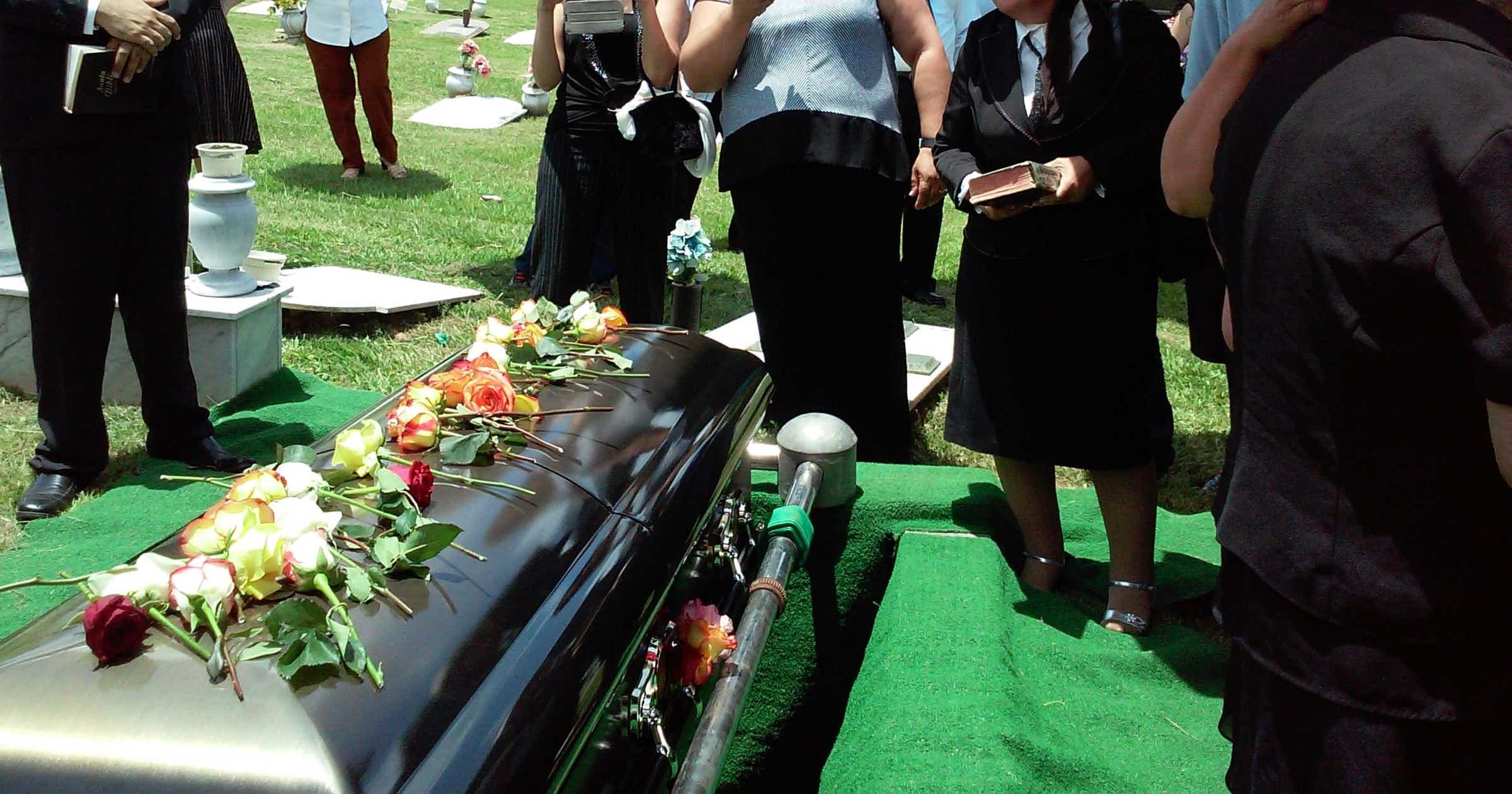 The process of embalming the body varies massively as there are different kinds of embalming which involve different processes. But essentially, preservation fluids are put inside the body as well as colourants. This preserves the body and also makes it look a lot more normal again.
The process of embalming the body varies massively as there are different kinds of embalming which involve different processes. But essentially, preservation fluids are put inside the body as well as colourants. This preserves the body and also makes it look a lot more normal again.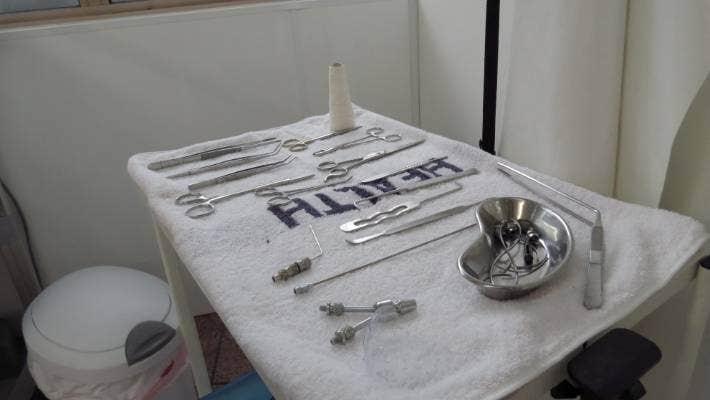 Full embalming is a much bigger and more complex process. Each and every one of the organs are removed (even including the brains), then they are scattered with a preserving powder and then everything is placed back inside the body in correct placement.
Full embalming is a much bigger and more complex process. Each and every one of the organs are removed (even including the brains), then they are scattered with a preserving powder and then everything is placed back inside the body in correct placement. If the body looks in any danger of leaking, they the mortician will apply some kind of nappy to collect any fluid and prevent the body from leaking out. The mortician tries to prevent the body from leaking any fluid. And so if the body looks as though it may lose fluid in this way, a nappy is put on.
If the body looks in any danger of leaking, they the mortician will apply some kind of nappy to collect any fluid and prevent the body from leaking out. The mortician tries to prevent the body from leaking any fluid. And so if the body looks as though it may lose fluid in this way, a nappy is put on.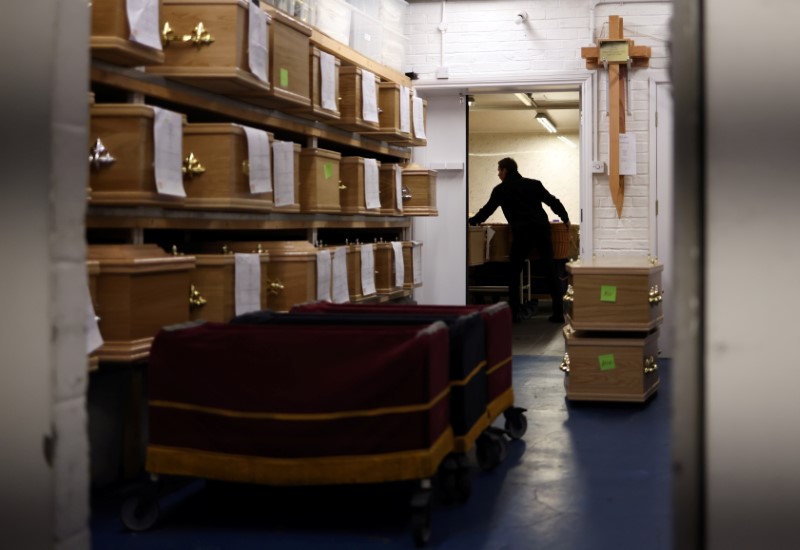 As we mention previously, there are many typed of embalming and the different kinds take different amounts of time. For example some embalming takes a few hours but some can take up to a couple of days for the process to be finished.
As we mention previously, there are many typed of embalming and the different kinds take different amounts of time. For example some embalming takes a few hours but some can take up to a couple of days for the process to be finished. Again, there are a lot of misconceptions about being an mortician. One of these is that the mortician is constantly around death. But actually the majority of time according to morticians themselves, is amongst the living - the families of the deceased.
Again, there are a lot of misconceptions about being an mortician. One of these is that the mortician is constantly around death. But actually the majority of time according to morticians themselves, is amongst the living - the families of the deceased.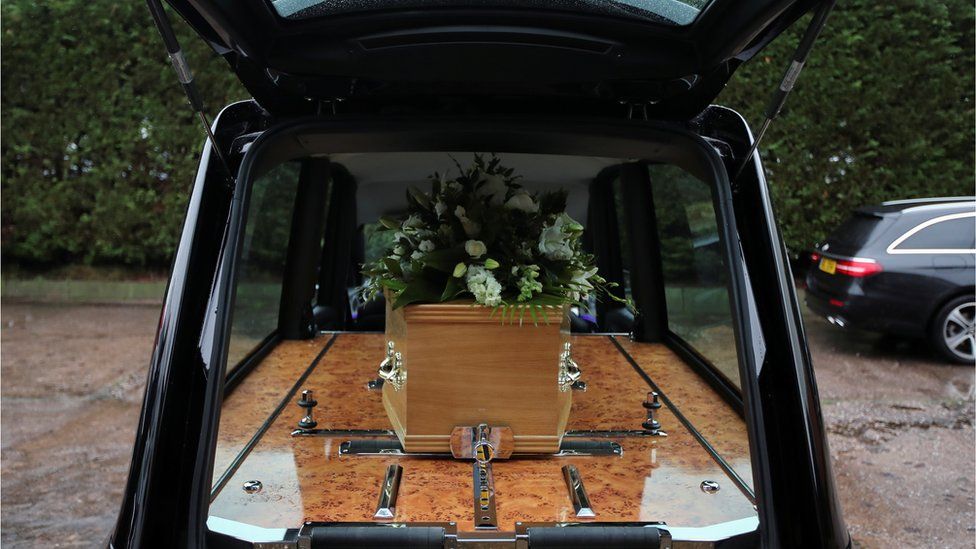 According to morticians, it is harder dealing with larger bodies - the larger it is the more difficult according to some. This is throughout the entire process from carrying the body from place to place, undressing and embalming. Because each step requires more work and takes more time.
According to morticians, it is harder dealing with larger bodies - the larger it is the more difficult according to some. This is throughout the entire process from carrying the body from place to place, undressing and embalming. Because each step requires more work and takes more time. One mortician had revealed that the smell of decomposition is string, but the best thing to do is not to shy away from the smell or to mask it with another. He claimed that the best thing to do is take two big inhales, after that you adjust and get used to it.
One mortician had revealed that the smell of decomposition is string, but the best thing to do is not to shy away from the smell or to mask it with another. He claimed that the best thing to do is take two big inhales, after that you adjust and get used to it.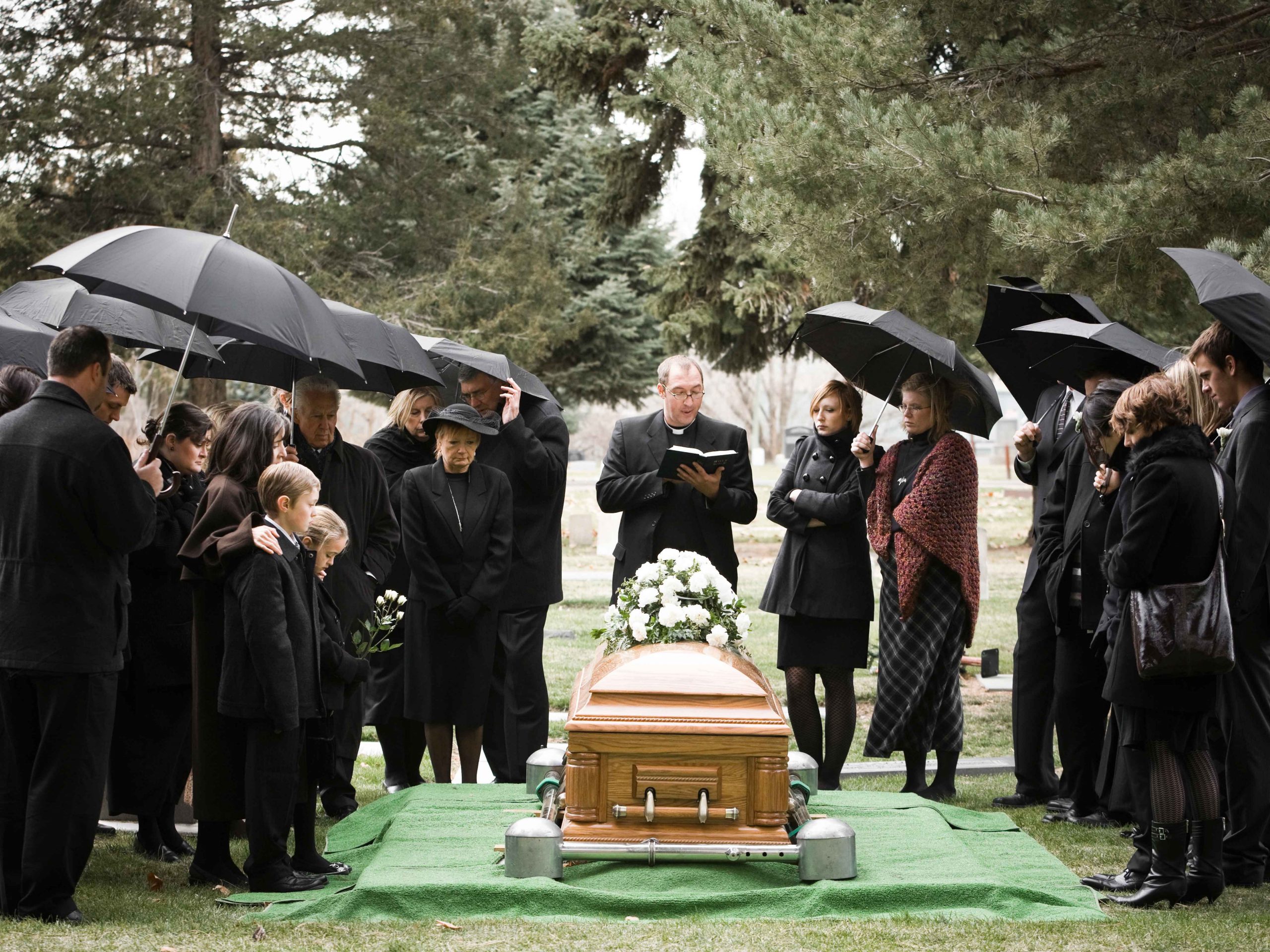 Morticians have revealed this dark secret about the realities of dealing with bodies. It is true that bodies do turn green eventually. The process of turning green always starts first around the stomach area, and then spreads to other parts of the body.
Morticians have revealed this dark secret about the realities of dealing with bodies. It is true that bodies do turn green eventually. The process of turning green always starts first around the stomach area, and then spreads to other parts of the body. It may sound strange because dealing with deceased bodies is a job very few have the capacity for. You would naturally think that it may require a lot of special qualifications. However that is no the case, you do not technically need qualifications to become an mortician.
It may sound strange because dealing with deceased bodies is a job very few have the capacity for. You would naturally think that it may require a lot of special qualifications. However that is no the case, you do not technically need qualifications to become an mortician.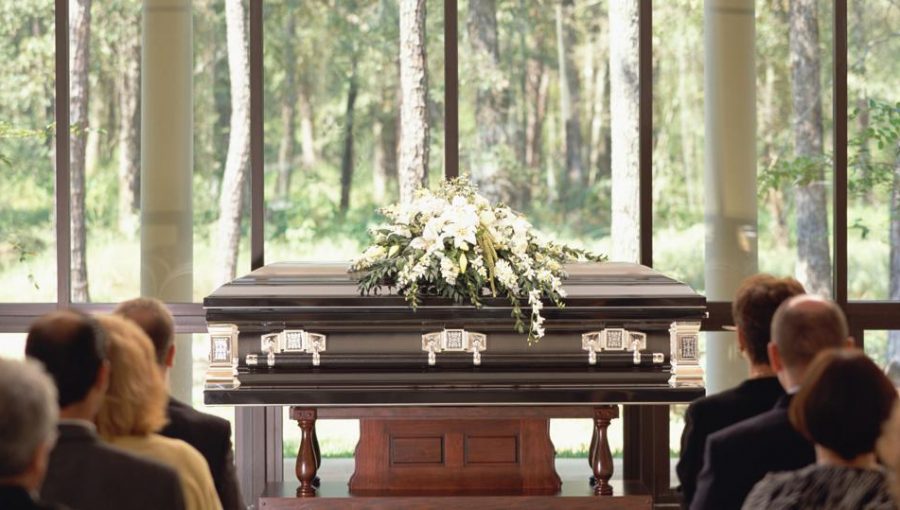 There is a common assumption that bodies are cold. This is because a living bod is warm and so in comparison a body is cold. But, it is actually just room temperature. However of course when it is kept in a fridge the body is cold to touch.
There is a common assumption that bodies are cold. This is because a living bod is warm and so in comparison a body is cold. But, it is actually just room temperature. However of course when it is kept in a fridge the body is cold to touch.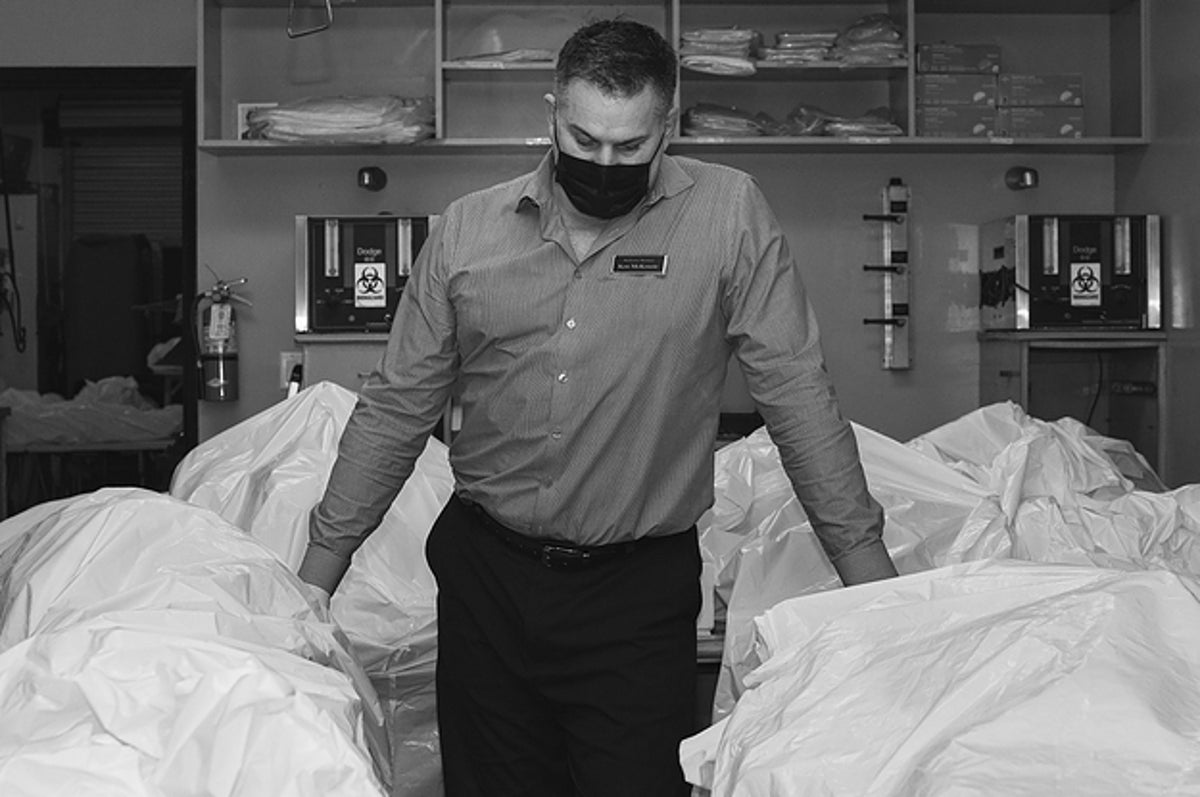 Rigor-mortis refers to a state when the limbs of a deceased body start to stiffen. It makes the body look and feel rigid and the body stays in the same position when moved. It does not happen to all bodies - even the majority - but with some it does occur.
Rigor-mortis refers to a state when the limbs of a deceased body start to stiffen. It makes the body look and feel rigid and the body stays in the same position when moved. It does not happen to all bodies - even the majority - but with some it does occur.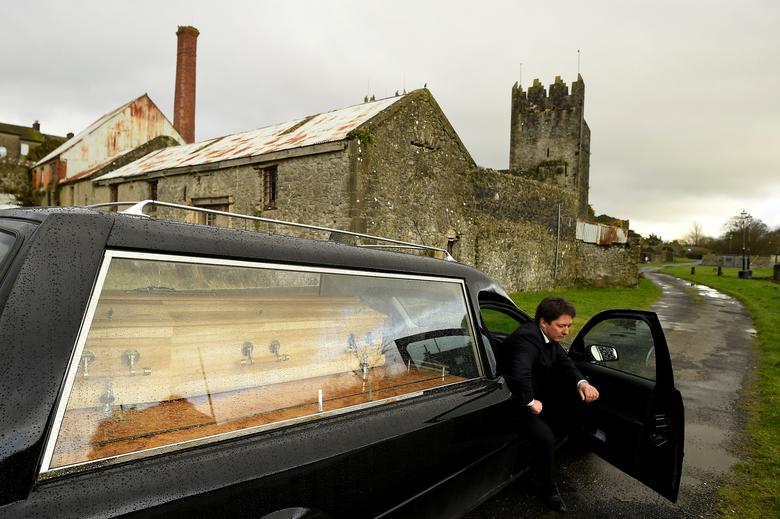 But, even when bodies do have rigor-mortis it is easily stopped it does not mean it is permanent. This happens by the mortician bending and moving the joints about for a while. The body then comes out its state rigor-mortis so that it then becomes more moveable again.
But, even when bodies do have rigor-mortis it is easily stopped it does not mean it is permanent. This happens by the mortician bending and moving the joints about for a while. The body then comes out its state rigor-mortis so that it then becomes more moveable again.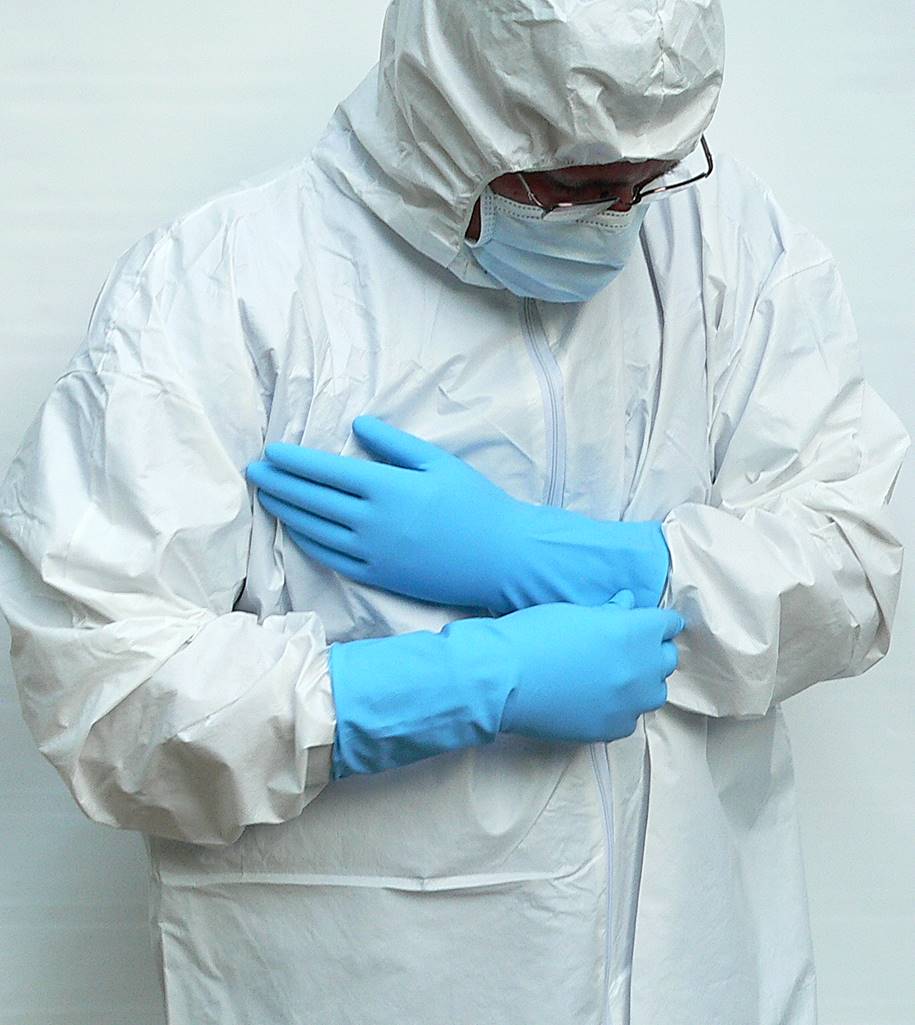 This again is very dependent. Because a lot of the time, the body will not be messy and the job is not messy at all.Sometimes in certain cases there is a lot of mess, which is sometimes inevitable. But, the morticians are geared up in protective clothing.
This again is very dependent. Because a lot of the time, the body will not be messy and the job is not messy at all.Sometimes in certain cases there is a lot of mess, which is sometimes inevitable. But, the morticians are geared up in protective clothing. Of course when having such a sensitive job there comes a lot of paperwork. Their records have to show the name of the deceased and their date of death as well as their age at the time of death. Also the place the body was transferred from and the date this happened. Also,, who was responsible for the transfer along with any valuables attached to the person.
Of course when having such a sensitive job there comes a lot of paperwork. Their records have to show the name of the deceased and their date of death as well as their age at the time of death. Also the place the body was transferred from and the date this happened. Also,, who was responsible for the transfer along with any valuables attached to the person. There is a very precise temperature that you can keep bodies at. This is between 3 and 5 degrees celsius. So the fridges are set between this temperature. Any lower and the body would start to freeze. Any higher and the body would start to decay and decompose more rapidly.
There is a very precise temperature that you can keep bodies at. This is between 3 and 5 degrees celsius. So the fridges are set between this temperature. Any lower and the body would start to freeze. Any higher and the body would start to decay and decompose more rapidly. Morticians have revealed this secret.If you leave a body in a fridge too long, a certain fungi will grow on it. The fungus is either orange or white and not found anywhere else other than a body when it is in those conditions. Out of the fridge, the fungus does not appear.
Morticians have revealed this secret.If you leave a body in a fridge too long, a certain fungi will grow on it. The fungus is either orange or white and not found anywhere else other than a body when it is in those conditions. Out of the fridge, the fungus does not appear.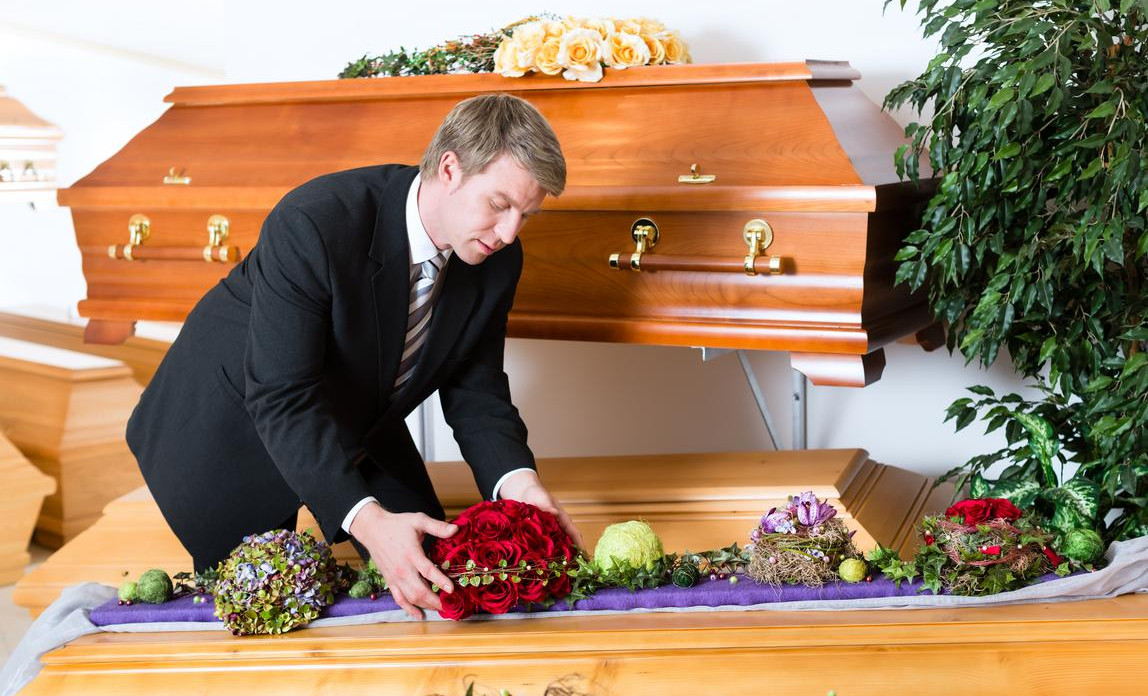 It has a very morbid reputation, and it is certainly understandable why people assume that it must be a very depressing job to have. But, according to morticians they clarify that it is not in fact a morbid job. Some even go as far to say it is just the same as any normal job.
It has a very morbid reputation, and it is certainly understandable why people assume that it must be a very depressing job to have. But, according to morticians they clarify that it is not in fact a morbid job. Some even go as far to say it is just the same as any normal job. Morticians have claimed that the more you try and avoid the smell - the worse it us.These tricks such as playing some toothpaste under your nostrils or trying not to breathe much actually only make the smell last longer than if you just don't try at all.
Morticians have claimed that the more you try and avoid the smell - the worse it us.These tricks such as playing some toothpaste under your nostrils or trying not to breathe much actually only make the smell last longer than if you just don't try at all. There is a misconception that bodies are collected and transported using a hearse. But these are rarely used, these are mainly for ceremonial purposes alone. So actually it is usually just ordinary mini van so that t is not obvious to the rest of the world what is happening.
There is a misconception that bodies are collected and transported using a hearse. But these are rarely used, these are mainly for ceremonial purposes alone. So actually it is usually just ordinary mini van so that t is not obvious to the rest of the world what is happening. To a grieving family, some comfort comes by looking at the peaceful expression on the face of their deceased loved one. But this takes a lot of work. The features have to be set in place it does not happen naturally which most people tend to assume...
To a grieving family, some comfort comes by looking at the peaceful expression on the face of their deceased loved one. But this takes a lot of work. The features have to be set in place it does not happen naturally which most people tend to assume... SENSITIVE MATERIAL. THIS IMAGE MAY OFFEND OR DISTURB. Park Bo-ram, a funeral director, cleans the body of a deceased at a funeral home in a medical center in Seoul, South Korea, November 4, 2020. Picture taken November 4, 2020. REUTERS/Heo Ran
SENSITIVE MATERIAL. THIS IMAGE MAY OFFEND OR DISTURB. Park Bo-ram, a funeral director, cleans the body of a deceased at a funeral home in a medical center in Seoul, South Korea, November 4, 2020. Picture taken November 4, 2020. REUTERS/Heo Ran
 Mortician Amy Cunningham revealed in an interview another method of achieving the expected look: “If you need to keep a deceased person’s hands folded neatly at their abdomen, but their arms keep falling down into the sides of the casket, you can gently bind their thumbs with a ponytail tie.”
Mortician Amy Cunningham revealed in an interview another method of achieving the expected look: “If you need to keep a deceased person’s hands folded neatly at their abdomen, but their arms keep falling down into the sides of the casket, you can gently bind their thumbs with a ponytail tie.” Protective caskets are sold under the guise of protecting the body from any outside factors, for example any of the outside penetrating in such as the earth or insects. But actually, it makes the inside a breeding ground for bacteria and encourages the inside to rot away.
Protective caskets are sold under the guise of protecting the body from any outside factors, for example any of the outside penetrating in such as the earth or insects. But actually, it makes the inside a breeding ground for bacteria and encourages the inside to rot away. Sometimes caskets explode. This is because of the buildup of methane gas can cause what people in the industry call “exploding casket syndrome”. The gas builds up util the pressure reaches a point where the gas will literally make the casket explode open. And so they have to be unsealed regularly.
Sometimes caskets explode. This is because of the buildup of methane gas can cause what people in the industry call “exploding casket syndrome”. The gas builds up util the pressure reaches a point where the gas will literally make the casket explode open. And so they have to be unsealed regularly. Pace makers can cause damage to the cremation machine because of the batteries inside of them. This is why it is so important for the undertaker to make sure the remove them in the first instance so that they are not still present during the cremation.
Pace makers can cause damage to the cremation machine because of the batteries inside of them. This is why it is so important for the undertaker to make sure the remove them in the first instance so that they are not still present during the cremation. Morticians use rose coloured lighting to give the appearance of pinky rosy flesh, rather than grey. Which of course is partially achieved by the staining of the flesh but sometime it is not enough and so the rosy coloured lighting helps to create this illusions too.
Morticians use rose coloured lighting to give the appearance of pinky rosy flesh, rather than grey. Which of course is partially achieved by the staining of the flesh but sometime it is not enough and so the rosy coloured lighting helps to create this illusions too. It sounds like a shocking statistic but around 120 gallons of waste are produced from an embalming. These include things such as blood, fecal matter, and the contents of the internal organs, as well as any chemicals that have been added which have been released from the body.
It sounds like a shocking statistic but around 120 gallons of waste are produced from an embalming. These include things such as blood, fecal matter, and the contents of the internal organs, as well as any chemicals that have been added which have been released from the body. What is even perhaps more shocking that realising just how much waste is produced from one embalming, is realising that it goes straight down the drain.And no, not a hazardous waste drain just the usual drain which we use daily. It is an uncomfortable thought.
What is even perhaps more shocking that realising just how much waste is produced from one embalming, is realising that it goes straight down the drain.And no, not a hazardous waste drain just the usual drain which we use daily. It is an uncomfortable thought.